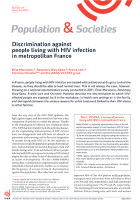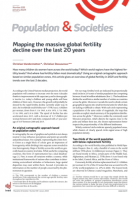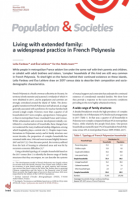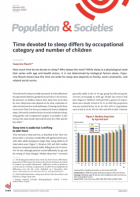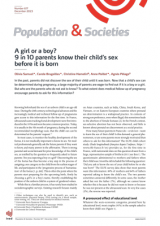
A girl or a boy? 9 in 10 parents know their child’s sex before it is born
Population and Societies
n° 617, Decembre 2023
https://doi.org/10.3917/popsoc.617.0001
Université Paris Nanterre/Cresppa
Université Paris Nanterre/Cresppa
Université Versailles St Quentin/Printemps–INED
Université Paris 1 Panthéon-Sorbonne/CESSP
Université de Créteil/Printemps
It is common practice in France for parents to ask about the sex of their unborn child. The national ELFE cohort study indicates that only 1 in 10 couples do not ask to know. The most highly educated parents, those who already have children (and of different sexes), and those who regularly attend religious services less often ask to know the child’s sex during pregnancy. Conversely, very young parents, those with a sex preference, and those who have had multiple consultations and ultrasound scans ask more frequently.
sex, gender, birth, pregnancy, ELFE cohort study, France
Table of contents
- Appendix A References
1.
In the past, parents did not discover the sex of their child until it was born. Now that a child’s sex can be determined during pregnancy, a large majority of parents are eager to find out if it is a boy or a girl. But who are the parents who do not ask to know? To what extent does medical follow-up of pregnancy encourage parents to ask for this information?
Knowing beforehand the sex of an unborn child is an age-old issue. During the 20th century, technological advances and the increasingly medical and technical follow-up of pregnancies gave access to this information for the first time. In France, ultrasound scans tracking foetal development were first introduced in the 1970s and soon became common practice. Today, it is usually in the 5th month of pregnancy, during the second recommended morphology scan, that the child’s sex can be determined at the parents’ request.1
In most cases, to monitor the healthy development of the foetus, it is not medically important to know its sex. Yet medical professionals generally ask the future parents if they want to know, and many answer in the affirmative. There is strong parental and social demand for prior knowledge of the child’s sex, as testified by the question so frequently asked to future parents: ‘Are you expecting a boy or a girl?’ Discovering the sex of the foetus has thus become a key step in the process of assigning a sex category to the child from the earliest stages of life, and participates in the ‘progressive process of humanization’ of the foetus [1, p. 260]. This is often the point where the parents start preparing for the upcoming birth, firstly by choosing a girl’s or a boy’s name, thereby establishing the position of the unborn child in a system of gendered values.
While this is a familiar process, it has rarely been studied in sociodemographic surveys. Existing research focuses mainly on Asian countries, such as India, China, South Korea, and Vietnam, or on Eastern European countries where prenatal sex determination is a widespread practice. In contexts of strong son preference, even when illegal, this sometimes leads to the abortion of female foetuses [2]. In the French context, sex-selective abortion has not been observed, and little is known about prenatal sex discernment as a social practice.
How many future parents in France do—or do not—want to learn the sex of their child? Is this demand a general phenomenon, or are some parents more strongly motivated than others to ask for this information? The ELFE child cohort study (Étude longitudinale française depuis l’enfance, https://www.elfe-france.fr/en) provides us, for the first time in France, with nationwide data on this question drawn from a large, representative sample of births in 2011 (see Box 1). The questionnaire administered to mothers and fathers when their child was 2 months old included the following question: ‘Did you ask to know the sex of your child before he or she was born?’ The ELFE survey data show that most parents want this information: 89% of mothers and 84% of fathers reported asking to know the child’s sex. The two parents sometimes answered differently. In some cases, the mother asked but not the father (7%), although we cannot know whether this is because he did not want to know or because he was not present at the ultrasound scan. In very few cases (2%), the reverse was reported.
1.1. A pronounced effect of educational level
Whatever the socio-economic categories, proxied here by educational level, most couples (91%) in the sample asked to know their child’s sex (Figure 1).
Some significant variations are nonetheless discernible. Asking about the child’s sex becomes less frequent as educational level increases. Among couples where the woman has a lower-secondary qualification, 96% have asked versus 86% among those with a post-graduate qualification. A similar gradient is found for fathers, among whom the proportions are 95% and 84%, respectively. Thus, the proportion of highly educated couples (15%) who did not want to know their child’s sex before the birth is 3 times higher than among low-educated couples (5%).
This variation by educational level may be due to social differences in attitudes to the medicalization of pregnancy, in the propensity to challenge dominant social norms, in the desire to be seen as having distinctive practices, or in the tolerance of uncertainty. For example, highly educated couples have a stronger tendency to distance themselves from the numerous social injunctions to prepare for the birth on the basis of the child’s sex [3].
1.2. A stronger propensity to ask among young parents expecting a first child
Alongside educational level, certain demographic, cultural, and family characteristics play a smaller role in the discerning the child’s sex before birth.
Young parents aged under 30 asked to know the child’s sex more often than the others (Figure 1).2 More specifically, among the small number of mothers aged under 25 (who represented 14% of the cohabiting couples), 97% asked about the child’s sex versus 92% at ages 25–29 and 89% at ages 30 and over. But the youngest women were also more often those expecting their first child, and being a first-time parent is also associated with a slightly higher propensity to ask: 92.5% versus 90% among parents who already have one or more children (Figure 2), for whom the desire to know depends partly on the sex of the existing child or children. When parents of two children had two boys or two girls, they were more likely to ask than when they already had a boy and a girl. This may be explained by the desire to have a gender ‘balance’ in the family, with at least one boy and one girl, as is commonly observed in Europe [4]. Parents wishing to achieve this ‘balance’ may be eager to find out as soon as possible whether they have succeeded. Knowing the child’s sex in advance gives them the time to get over any temporary disappointment should the child’s sex not be what they wished for. This has already been shown in analyses based on interviews with families expecting a child [3].
Preference for a daughter or a son also affects the desire to know the child’s sex before birth. Slightly fewer than half of the mothers (45%) and fathers (41%) expressed a preference for a boy or a girl, and these couples more often wanted to know the child’s sex in advance. Conversely, the fathers, and even more so, the mothers who reported no preferences for the sex of the unborn child3 less often asked to be told (Figure 1). For example, 90% of women who reported no sex preference for their first child wanted to know if it was a boy or a girl versus slightly more than 97% of those who reported a preference. This tendency among mothers is found for all birth orders. The most highly educated parents, mentioned above, are those who both least often asked to know the child’s sex and those who least often expressed a sex preference. For example, 62% of mothers with a post-graduate qualification reported no preference versus 48% of the least educated mothers.
The mothers and, to a lesser extent, the fathers who regularly attend religious services asked to know the sex of the child much less often than the others: 86% among the mothers who attend at least once a month compared with 90% of those who attend occasionally and 92% of those who never attend (Figure 1). This does not signify, however, that these religiously inclined parents are more distanced from gender norms; the shares reporting a preference or no preference are the same as among those who attend religious services occasionally or not at all.
1.3. A modest effect of pregnancy follow-up
The sex of a child is determined in a specific setting, generally that of a pregnancy follow-up consultation, where the parents have access to the technology required. By offering to tell them the sex of their child or answering their request for this information, health professionals are contributing to today’s widespread social expectation that parents will have this knowledge before the baby is born. Conditions of access to this information may differ, however, according to the mode of pregnancy follow-up, i.e. the type of professional consulted or the number of consultations and ultrasound scans. Seven antenatal consultations and three scans are recommended during pregnancy, but 65% of the women in the sample had eight or more consultations, and 64% had more than three scans.
Parents were slightly more likely to learn the child’s sex during pregnancy in certain situations. When the woman benefited from a large number of antenatal consultations (12 or more) or scans (five or more), couples slightly more frequently asked to know the child’s sex (Table 1). The small observed differences4 may be partly due to ‘windfall effects’ linked to the number of consultations. Each visit and ultrasound scan provides a new opportunity to ask. Moreover, women who have unusually high numbers of consultations and scans may have medical problems for which it is important to know the child’s sex.
When the mother was followed primarily by an obstetrical specialist (gynaecologist, obstetrician, or midwife), couples asked to know the sex slightly more often (91%) than when she was followed by a general practitioner (88%). The small minority of pregnant women followed by general practitioners—who rarely perform ultrasound scans, which limits the opportunities for a couple to know the child’s sex—may have been unable to access a specialist or may have preferred a less medicalized form of follow-up.
***
The question ‘Is it a boy or a girl?’ is now routinely asked to future parents by family and friends. Asking to know the sex of an unborn child has become a norm with which just 1 in 10 couples do not wish to comply. Parents generally argue that asking to know the sex is justified by the need to plan appropriately for the birth by buying the right clothes, choosing a name, decorating the bedroom, preparing older siblings for the arrival of a sister or brother, and preparing oneself to become a mother or a father of a girl or a boy [5]. They also argue that learning the child’s sex is an important moment for establishing a bond with their future child and personalizing the foetus as a gendered human being [6, 7]. These arguments and practices reveal the central importance of gender in the pregnancy. The desire to know the sex of an unborn child can be seen as a manifestation of the process of placing each individual in a gender category that associates anatomical sex with a series of masculine and feminine social roles. Learning a child’s sex before birth is one of a set of practices whereby most families distinguish the arrival of a son or a daughter. To what extent this advance knowledge influences the subsequent socialization of small girls and small boys is a question that needs to be further explored.
1.3.1. Box 1. Data and method
ELFE follows a sample of 18,300 families who had a child in 2011, and regularly asks them questions from the time the child was born until adulthood. The data were collected by phone, from both parents, when their child was 2 months old.
The results presented here concern the most common parental configurations in 2011, i.e. couples comprising a man and a woman who were cohabiting when the child was 2 months old. In the survey sample, 5% of children were living with just one parent at age 2 months, and only 28 children had same-sex parents; these family configurations were not subsequently considered. The study subsample thus includes 12,393 children whose parents both independently answered the question on asking about the child’s sex. The analysis compares couples where at least one partner asked to know the sex with those where neither partner asked. Defined in this way, couples ‘who asked’ represent 91% of the cohabiting couples in the sample. While the survey question refers to the parents asking to know the sex, it is very possible that, in some cases, it was the health professional who spontaneously offered to tell them.
It would be useful to conduct further large-scale surveys to update these 2011 ELFE data, taking account of new developments in early sex determination techniques and the medicalization of pregnancy, and changes in parental attitudes towards knowing their child’s sex before birth.
Appendix A References
-
[1] Larrieu G., 2021, Naître déjà fille ou garçon. Processus d’humanisation et de sexuation du fœtus pendant la grossesse, Terrains & travaux, 39, 241–266. https://doi.org/10.3917/tt.039.0241
-
[2] Guilmoto C. Z., 2015, La masculinisation des naissances. État des lieux et des connaissances, Population, 70(2), 201–264. https://doi.org/10.3917/popu.1502.0201
-
[3] Pélage A., Brachet S., Brugeilles C., Paillet A., Rollet C., Samuel O., 2016, ‘Alors c’est quoi, une fille ou un garçon ?’. Travail de préparation autour du genre pendant la grossesse, Actes de la recherche en sciences sociales, 214(4), 30–45. https://doi.org/10.3917/arss.214.0030
-
[4] Mills M., Begall K., 2010, Preferences for the sex-composition of children in Europe: A multilevel examination of its effect on progression to a third child, Population Studies, 64(1), 77–95. https://doi.org/10.1080/00324720903497081
-
[5] Barnes M. W., 2015, Anticipatory socialization of pregnant women: Learning fetal sex and gendered interactions, Sociological Perspectives, 58(2), 187–203. https://doi.org/10.1177/0731121414564883
-
[6] Larkin L., 2006, Authentic mothers, authentic daughters and sons: Ultrasound imaging and the construction of fetal sex and gender, Canadian Review of American Studies, 36(3), 273–291. https://doi.org/10.3138/CRAS-s036-03-03
-
[7] Pélage A., 2019, Our ‘baby’ on YouTube: The gendered life stories of the unborn, European Journal of Life Writing, 8, 69–90. https://doi.org/10.21827/ejlw.8.35666
Other techniques can also be used to identify sex, such as amniocentesis, placental biopsy, DNA testing via a blood sample, urine testing, etc. They are used mainly for medical reasons.
These and the following results remain valid after controlling for age, educational level, sibship size, sex preference, and religiosity (see regression model in online supplementary material: https://doi.org/10.34847/nkl.992fw7j4)
The following question was asked in the survey conducted 2 months after the birth: ‘Before or during your pregnancy, personally speaking, did you have a preference for a boy, for a girl, or no preference?’
These differences are significant after controlling for mother’s age, mother’s educational level and sibship size, the type of professional and the number of scans, but not for the number of antenatal visits (see regression model in online supplementary material https://doi.org/10.34847/nkl.992fw7j4).
It is common practice in France for parents to ask about the sex of their unborn child. The national ELFE cohort study indicates that only 1 in 10 couples do not ask to know. The most highly educated parents, those who already have children (and of different sexes), and those who regularly attend religious services less often ask to know the child’s sex during pregnancy. Conversely, very young parents, those with a sex preference, and those who have had multiple consultations and ultrasound scans ask more frequently.
Olivia Samuel
Carole Brugeilles
Christine Hamelin
Anne Paillet
Agnès Pélage
Cite the article
Olivia Samuel, Carole Brugeilles, Christine Hamelin, Anne Paillet, Agnès Pélage, A girl or a boy? 9 in 10 parents know their child’s sex before it is born, 2023, Population and Societies, no. 617
 This document may be reproduced free of charge on paper or online using our Creative Commons licence.
This document may be reproduced free of charge on paper or online using our Creative Commons licence.

